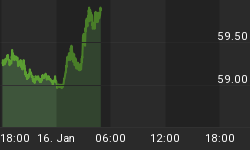After the comparatively high-volume selloff on Friday, the stock market responded with a low-volume rebound on Monday (except for new IPO FacePlant, which is now 18.4% below the IPO price) and a low-volume, water-treading session today. Monday's rebound was punctuated by chirps of "oversold!" from certain financial news networks, but unfortunately nothing fundamental haschanged other than the price.
Existing Home Sales were reported today as-expected. Inventories of existing homes rose, but this was strictly in line with the normal seasonal pattern (see Chart, which I mainly show to illustrate a neat new Bloomberg function I discovered).

Using the same style chart, though, consider what happened to the median sales price of Existing Homes. Ordinarily, the non-seasonally-adjusted price in April is down 0-5% from year-end prices. This year, though, NSA prices are up about 10%.

To the man who has a hammer, everything looks like a nail, it's true. But to me, this is a remarkable chart that smacks of asset price inflation in housing. Consider that Existing Home Sales, at a 4.62mm seasonally-adjusted pace, are running at about 65% of 2005's pace, and only 88% of 2000's pace. The pace of sales is still quite a bit depressed, in other words, yet the year-on-year rise in prices is about 10.4% (see the chart below, which is a more-normal time series). Prices in other words rose much more-rapidly in April than they typically do at this time of year, despite the level of unemployment and other, various measures of economic softening.

Don't read too much into one month's data, even if it is entirely consistent with what should be happening given the accelerating rise in bank lending and the persistent rise in money supply. But be wary.
Housing is, as I've been writing for a while, near fair-value or even slightly cheap after a long period where it was overvalued compared to traditional relationships to income and rents. (The same people who today tell me I am too bearish on stocks are the ones who told me I was too bearish on housing back in the mid-2000s. But I'm not even that bearish on stocks - I'm just not bullish enough for some people!) It is, as commodities are, a classic "real asset" that doesn't return very much, but tends to keep up with inflation over long periods of time. It ought to respond to money growth, now that the bubble seems to have run its course. However, I'm as surprised as you are that it seems to be happening - I thought, as did many of you, that housing prices would fall straight through fair value and become cheap. And they probably would have, had central banks not printed so much money.
Ironically, the other classic "real assets" are commodities, and they continue to get pummeled. The DJ-UBS index lost another 1% today, with grains and softs losing 3.4% and 2.4% respectively. I think that what is happening is that since commodities are traded and consumed internationally, it is easier to get confused about the role that the global growth dynamic should play. Case in point is cotton, which was -3.9% today and now sits 68% off the highs from March 2011. Someone in China mentioned that yarn production may drop below 20 million metric tons this year, from 20.5 million last year, due to weak global growth. -0.5 million tons translates into -68% on the price? That's one inelastic supply curve! But weak global growth clearly shouldn't really affect the price of a house in Idaho, so this error doesn't translate as easily to housing as a real asset. Therefore, housing prices are now rising (maybe) while commodity prices trade incredibly cheap (although gasoline futures prices rose 5 cents on Monday).
It has been a long time since it was worthwhile to watch the housing numbers, but today's pricing data raises my interest in the New Home Sales figures tomorrow (Consensus: 335k vs 328k). It isn't the number of new sales that interests me; that number is low and even with a high-side surprise will continue to be low compared to old standards for a long time. But since the inventory of new homes is at a life-of-series low (see Chart) I will be looking for signs that the bids are starting to reach up for the offers.¹

The median price series for New Home Sales isn't as smooth as the one for Existing Home Sales, simply because the absolute number of sales is much smaller. But if there really is something going on in home prices, I'll expect to see it in New Home Sales in the next month or two as well.
In any event, with 1-year CPI swaps ending today at 1.44% and 2-year swaps at 1.69% - let's just say I wouldn't want to be caught shorting that market at these levels! Core inflation is at 2.3%, so you'd better be expecting either a sharp fall in core or a huge drop in gasoline prices. Neither appears to me to be in the cards - there's a better chance of gasoline prices falling in the near-term if there's an economic train wreck in Europe, but in that case go out another year: the 2-year at 1.69% implies 1y, 1y forward inflation of only 1.94%.
¹As an aside, a reader in Phoenix told me recently that bids there and in Vegas have been getting jumpy recently, all of a sudden starting a few months ago. "Pull up Redfin and try to call an agent about a property in Mesa, Tempe or Scottsdale. If a house is out on MLS more than a day they likely have 10 bids stacked with an agreement above the ask. This just started ~60-90 days ago and has accelerated. Crazy, like no one remembers 2008-2010." It was an interesting anecdote - but now the data are reinforcing that observation.
















